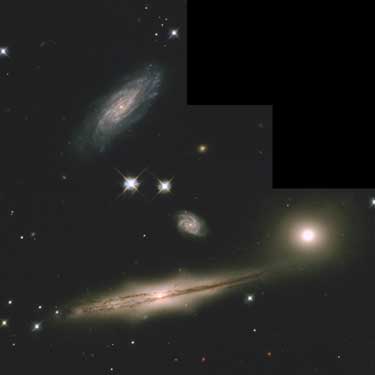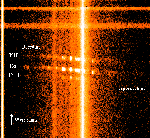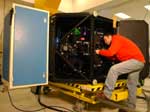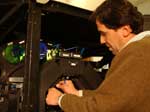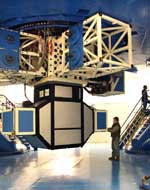|
Media Contacts:
|
|
|
Peter Michaud
Gemini Observatory, Hilo, Hawai`i Phone: 808/974-2510, Cell: 808/937-0845 E-mail: pmichaud@gemini.edu |
Jennifer Akingkubedaggs Gemini Observatory, Hilo, Hawai`i Phone: 808/974-2607 Cell: 808/960-2697 E-mail: jaking@gemini.edu |
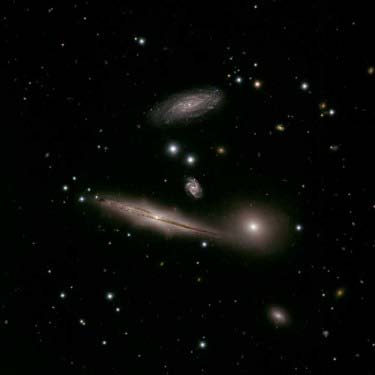 Gemini Observatory - GMOS-S Commissioning Team HCG 87 imaged with GMOS-S |
HCG 87 imaged with the Hubble Space Telescope |
En Español - Versión adaptada en Chile
Gemini Observatory's new imaging spectrograph, without the help of adaptive optics, recently captured images that are among the sharpest ever obtained of astronomical objects from the ground.
Among the images and spectra acquired during recent commissioning of the Gemini Multi-Object Spectrograph (GMOS) on the 8-meter Gemini South Telescope, one image is particularly compelling. This Gemini image reveals remarkable details, previously only seen from space, of the Hickson Compact Group 87 (HCG87). HCG87 is a diverse group of galaxies located about 400 million light years away in the direction of the constellation Capricornus. A striking comparison with the Hubble Space Telescope Heritage image of this object, including resolution data, can be viewed at http://www.gemini.edu/media/images_2003-3.html.
"Historically, the main advantage of large ground-based telescopes, like Gemini, is their ability to collect significantly more light for spectroscopy than is possible with a telescope in space," said Phil Puxley, Associate Director of the Gemini South Telescope. He explains, "The Hubble Space Telescope is able to do things that are impossible from the ground. However, ground-based telescopes like Gemini, when conditions are right, approach the quality of optical images now only possible from space. One key area - spectroscopy of faint objects, which requires large apertures and fine image quality - is where large telescopes like Gemini provide a powerful, complementary capability to space-based telescopes."
GMOS-South is currently undergoing commissioning on the 8-meter Gemini South Telescope at Cerro Pachón, Chile. "GMOS-South worked right out of the box, or rather, right out of the 24 crates that brought the 2-ton instrument to Chile from Canada and the UK - just like its northern counterpart did when it arrived on Hawaii's Mauna Kea," says Dr. Bryan Miller, head of the commissioning team. "The GMOS program demonstrates the advantage of building two nearly identical instruments. Experience and software from GMOS-North have helped us commission this instrument more rapidly and smoothly than we could have done otherwise," explains Dr. Miller. He adds, "Although the images from GMOS-South are spectacular, the instrument is primarily a spectrograph and that is where its capabilities are most significant for scientists." GMOS-South is expected to begin taking science data in August 2003.
As a multi-object spectrograph, GMOS is capable of obtaining hundreds of spectra in one "snapshot." The ability to deliver high-resolution images is a secondary function. "It used to take an entire night to obtain one spectrum," explains Dr. Inger Jørgensen, who led the commissioning of the first GMOS instrument on the Frederick C. Gillett Gemini Telescope (Gemini North) over a year ago. "With GMOS, we can collect 50-100 spectra simultaneously. Combined with Gemini's 8-meter mirror, we are now able to efficiently study galaxies and galaxy clusters at vast distances - distances so large that the light has traveled for half the age of the Universe or more before reaching Earth. This capability presents unprecedented possibilities for investigating how galaxies formed and evolved in the early Universe."
GMOS achieves this remarkable sensitivity partly because of its technologically advanced detector, which consists of over 28 million pixels, and partly because of multiple innovative features of the Gemini dome and telescope that reduce local atmospheric distortions around the telescope. "When we designed Gemini, we paid careful attention to controlling heat sources and providing excellent ventilation," said Larry Stepp, former Gemini Optics Manager. Stepp elaborates, "For example, we constructed 3-story-high vents on the sides of the Gemini enclosures. It is great to see this image that provides such a dramatic validation of our approach."
"The twin Gemini Telescopes offer a unique advantage," explains Director of the Gemini Observatory Dr. Matt Mountain. "Now that both telescopes are equipped with nearly identical GMOS instruments, we have created an unprecedented uniform platform to coherently study and take deep spectra of any object in the northern or southern sky at optical wavelengths."
Upgrades to GMOS-South that will increase its variety of capabilities are planned even as the instrument is undergoing commissioning. An Integral Field Unit (IFU) on GMOS-South is anticipated to begin commissioning in early 2004. Jeremy Allington-Smith, leader of the IFU team at the University of Durham said, "GMOS-South will soon be fitted with an integral field unit like its sister on Gemini North. Made by the University of Durham, it uses more than a thousand optical fibers, tipped at each end with microscopic lenses, to dissect the object under study. This gives GMOS a 3-D view of the target, in which each pixel in the image is replaced by a spectrum. This innovation allows GMOS to make detailed maps of, for example, the motion of stars and gas in galaxies."
GMOS was built as a joint partnership between Gemini, Canada and the UK. Separately, the U.S. National Optical Astronomy Observatory provided the highly capable detector subsystem and related software (http://www.noao.edu/usgp). It is anticipated that GMOS-South will be available for full scientific operations in August 2003 when astronomers from the seven-country Gemini partnership will begin using the instrument for a wide variety of scientific studies.
Imágenes del nuevo espectrógrafo del Observatorio Gemini compiten con las tomadas desde el espacio
|
Contacto para prensa:
|
|
Maria Antonieta Garcia |
(Junio 30, 2003-Hilo,HI) Recientemente y sin la ayuda de la óptica adaptativa, el nuevo espectrógrafo de imagen del Observatorio Gemini fue capaz de capturar imágenes consideradas como las más nítidas que alguna vez hayan sido obtenidas de objetos astrónomicos desde la Tierra.
Entre las imágenes y espectros adquiridos durante la reciente verificación del GMOS (espectrógrafo multiobjeto de Gemini) en el telescopio de 8 metros de Gemini Sur, se obtuvo una imagen que es particularmente sorprendente. Esta revela detalles sin precedentes , previamente sólo posibles de ser vistos desde el espacio, del Grupo Compacto Hickson 87 (HCG87). El HCG87 es un grupo de diversas galaxias ubicadas a 400 millones de años luz en dirección hacia la constelación de Capricornio. Una espectacular comparación con la misma imagen que fuera captada por el Telescopio Espacial Hubble, puede ser vista en http://www.gemini.edu/media/images_2003-3.html.
"Históricamente, una de las principales ventajas de un telescopio gigante de base en tierra, como Gemini, es su habilidad de capturar significativamente más luz para espectroscopía de lo que es posible con un telescopio en el espacio", aseveró el Dr. Phil Puxley Director Asociado del telescopio de Gemini Sur. Más adelante explica "el Telescopio Especial Hubble es capaz de hacer cosas que son imposibles de realizarse desde tierra. Sin embargo, los telescopios como Gemini, desde tierra, cuando tienen las condiciones óptimas, consiguen la calidad de imágenes ópticas que hasta ahora sólo eran posibles capturar desde el espacio. Un factor clave- la espectroscopía de objetos opacos, los cuales requieren de grandes aperturas y calidad de imagen fina - es cuando los telescopios como Gemini brindan una poderosa capacidad complementaria a los telescopios espaciales".
GMOS Sur se encuentra actualmente en etapa de verificación en el telescopio de 8 metros de Gemini Sur ubicado en el Cerro Pachón, IV región de Chile. "GMOS Sur empezó a funcionar apenas salió de su embalaje, o más específicamente, apenas salió de las 24 cajas que traían este instrumento de 2 toneladas hasta Chile proveniente de Canadá y del Reino Unido – similar a lo que ocurrió con su par cuando llegó a Mauna Kea en Hawaii", dijo el Dr. Bryan Miller, líder del equipo de verificación. "El programa de GMOS demuestra la ventaja de construir dos instrumentos practicamente idénticos. La experiencia y el software utilizadas en el Norte nos han ayudado a verificar el instrumento de una manera más rápida y contínua de lo que podríamos haberlo hecho sin ello", explica el Dr. Miller quien agrega "aunque las imágenes de GMOS Sur son espectaculares , el instrumento es principalmente un espectrógrafo y allí es donde sus capacidades son más significativas para los científicos". Se estima que el GMOS Sur comience a tener información científica en agosto del 2003.
Como espectrógrafo multiobjeto , GMOS es capaz de obtener cientos de espectros con un sólo "presionar del obturador". La habilidad de entregar imágenes de alta resolución es una función secundaria. "Solía demorarse toda una noche para obtener un espectro" explica la Dra. Inger Jørgensen, quien lideró hace poco más de un año, la verificación del primer instrumento GMOS en el telescopio Frederick C. Gillet de Gemini Norte."Con GMOS, podemos capturar entre 50 a 100 espectros simultáneamente. Combinados con el espejo de 8 metros de Gemini, somos capaces ahora de estudiar eficientemente galaxias y cúmulos de galaxias en grandes distancias - distancias tan grandes que la luz ha viajado la mitad de la edad del Universo o más antes de alcanzar la Tierra. Esta capacidad presenta posibilidades imprecedentes para la investigación de cómo se formaron y evolucionaron las galaxias en el temprano Universo".
GMOS logra esta sensibilidad tan importante debido a su detector tecnológicamente avanzado, el cual está conformado de 28 millones de pixeles, y parcialmente por las características de innovación múltiple del domo y telescopio de Gemini que reducen las distorsiones atmosféricas locales alrededor del telescopio. "Cuando diseñamos Gemini prestamos especial atención a controlar las fuentes de calor y a brindar una excelente ventilación" señala Larry Stepp, antiguo Gerente de Optica de Gemini. El agrega "Por ejemplo, nosotros construimos unas persianas de ventilación de 3 pisos de alto en los costados de Gemini. Es grandioso ver esta imagen que viene a validar nuestros objetivos".
"Los telescopios gemelos de Gemini brindan una ventaja única" señala el Director del Observatorio Gemini , Dr. Matt Mountain. "Ahora que ambos telescopios están equipados con casi idénticos instrumentos GMOS, hemos creado una plataforma uniforme sin precedentes para estudiar de una forma coherente y tomar espectros profundos de cualquier objeto en el cielo del norte o del sur en longitudes de ondas ópticas".
Mejoras al GMOS Sur que incrementarán su variedad de capacidades están siendo planificadas incluso mientras el instrumento se encuentra en etapa de verificación. Se anticipa que una Unidad de Campo Integral (IFU) estaría planificada para ser verificada en GMOS Sur a principios del 2004. Jeremy Allington - Smith líder del equipo de IFU de la Universidad de Durham, dijo "GMOS Sur pronto se equipará con una Unidad de Campo Integral al igual que su par en el Gemini Norte. Construido por la Universidad de Durham, la unidad utiliza más de mil fibras ópticas, las cuales poseen lentes microscópicos en cada una de sus puntas, para analizar el objeto en estudio. Esto le otorga a GMOS una vista tridimensional del objeto, en el cual cada pixel en la imagen es reemplazada por un espectro. Esta innovación permite que GMOS haga un mapa detallado de, por ejemplo, el movimiento de las estrellas y gas en las galaxias".
GMOS fue construído como una asociación entre Gemini, Canada y el Reino Unido. Separadamente el Observatory Astronómico Naval de los Estados Unidos aportó con el subsistema de detector altamente sensible y su correspondiente software (http://www.noao.edu/usgp). Se estima que GMOS Sur estará de lleno en operaciones científicas en agosto del presente año cuando los astrónomos de los siete paises miembros del consorcio de Gemini comenzarán a utilizar el citado instrumento para una gran variedad de estudios científicos.
Image Resources
 Gemini Observatory - GMOS-S Commissioning Team HCG 87 imaged with GMOS-S |
|
|
During commissioning in early 2003 of the Gemini Multi-Object Spectrograph (GMOS) on the Gemini South Telescope, images and spectra were obtained of the group of galaxies known as the Hickson Compact Group 87 (HCG 87). The Gemini image (shown, left) compares very favorably with the Hubble Space Telescope Heritage image of this same field and illustrates the remarkable resolution that is possible with Gemini when atmospheric conditions are optimal. The three Gemini images used to make the color composite image have resolutions between 0.36 and 0.5 arcseconds (full-width-half-max) and an unsharp mask has been applied to highlight details in the major galaxies. Technical details on the images can be found here. |
|
|
About Hickson Compact Group 87: One of the primary galaxies of the HCG87 group is an edge-on galaxy with dust lanes, which is a beautiful example of a box/peanut shaped central bulge that the eye perceives as an X-shaped structure. This morphology is due to the vertical instability of the orbits of millions of stars going around the center of the galaxy. This can be caused by interactions with other galaxies, including the accretion of dwarf galaxy companions, or by the presence of a bar-shaped structure. Thin bars are unstable structures that buckle about their midpoints out of the plane of the bar. The warp in the disk of the galaxy and the lack of a clear bar signature in the galaxy's spectrum suggest that the X-structure in this galaxy is due to an interaction. The image also includes other galaxies including a more face-on spiral and an elliptical. All of these galaxies move through space together and perform a slow graceful gravitational dance as they evolve and influence each other's structure. References: "The Nature of Boxy/Peanut-Shaped Bulges in Spiral Galaxies". Bureau, M.; Freeman, K. C. The Astronomical Journal, 118, 126-138, July 1999. "A Merger Origin for X Structures in S0 Galaxies". Mihos, J. Christopher; Walker, Ian R.; Hernquist, Lars; Mendes de Oliveira, Claudia; Bolte, Michael. The Astrophysical Journal Letters, 447, L87, July 1995. "Orbital dynamics of three-dimensional bars - III. Boxy/peanut edge-on profiles". Patsis, P. A.; Skokos, Ch.; Athanassoula, E. The Monthly Notice of the Royal Astronomical Society, 337, 578-596, December 2002. |
|
